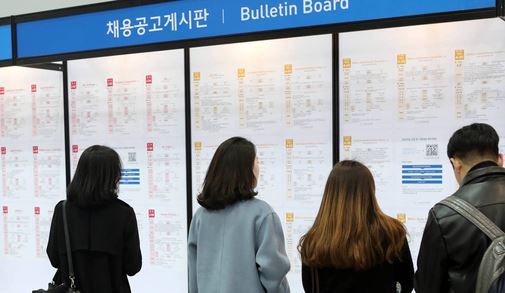[News Focus] 1 in 5 young Koreans de facto out of work
By Kim Yon-sePublished : Nov. 5, 2019 - 16:56
SEJONG -- The Moon administration has claimed that the number of jobless Koreans aged between 15 and 29 was 313,000 as of September, meaning youth unemployment rate fell from above 10 percent to 7.3 percent.
This might suggest to some that at least 9 out of 10 Koreans in that age group are employed despite the tough hiring conditions in the job market.
But most employment researchers say the figure doesn’t reflect the reality facing jobseekers, raising the necessity of putting more focus on the Supplementary Index III for Employment, provided by Statistics Korea.
The index refers to the extended (or sentiment-reflected) jobless rate, which reflects underemployment as well as unemployment. People deemed to be among the “extended jobless” include temporary employees who work fewer than 36 hours a week and want to work more hours, as well as seasonal workers who are out of work for part of the year.
According to the Supplementary Index III for Employment, the extended jobless rate for those aged 15-29 reached 21.1 percent in September, the most recent month for which statistics are available.
This might suggest to some that at least 9 out of 10 Koreans in that age group are employed despite the tough hiring conditions in the job market.
But most employment researchers say the figure doesn’t reflect the reality facing jobseekers, raising the necessity of putting more focus on the Supplementary Index III for Employment, provided by Statistics Korea.
The index refers to the extended (or sentiment-reflected) jobless rate, which reflects underemployment as well as unemployment. People deemed to be among the “extended jobless” include temporary employees who work fewer than 36 hours a week and want to work more hours, as well as seasonal workers who are out of work for part of the year.
According to the Supplementary Index III for Employment, the extended jobless rate for those aged 15-29 reached 21.1 percent in September, the most recent month for which statistics are available.

This means that 899,493 out of the economically active population for the age group (4.263 million) are still looking for jobs.
On a monthly basis, the extended youth unemployment rate continued to stay above 20 percent during the term of President Moon Jae-in, who took office in May 2017. Further, it surpassed the 25 percent mark in March and April 2019.
While the government highlighted that the number of employed in their 20s has recently increased, some experts remain skeptical about the quality of the jobs created.
A report from the Labor Research Institute of Korea University was quoted by a news outlet as saying that “the improvement in youth hiring could be attributable to an increase in part-time or short-term jobs rather than an improvement in stable jobs.”
The report pointed out that it is urgent for the government to push for the creation of fundamentally stable jobs, citing the extended unemployment rate.
In May 2017, President Moon Jae-in showcased an electronic dashboard to the media, which was set up in the presidential office for the purpose of monitoring the number of jobs created.
Young people including college students were pinning high hopes on the new administration. But they have not seen the president pose beside the dashboard at any time in the 30 months since.
A certain portion of college students are saddled with debt from tuition loans combined with low opportunity for regular employment.
During Moon’s term, many microbusiness owners including self-employed individuals had to shut up shop as a result of the huge cost burden the government imposed by implementing drastic minimum wage hikes in 2018 and 2019.

Young people, accordingly, faced a shortage of part-time jobs. And Moon’s earlier pledge to create as many jobs as possible for people in their 20s has gone unfulfilled amid an economic slowdown, despite supposedly allocating large sums to promote employment.
The Moon administration has reportedly poured about 50 trillion won ($43 billion) in taxpayer money, involving a supplementary budget and stabilization fund, into job creation efforts.
During his 2017 presidential campaign, candidate Moon promised to create 800,000 jobs if elected. His employment pledge had wide appeal, including among young voters.
According to a survey by Gallup Korea, which was released on Nov. 2, 52 percent of the 1,000 Koreans predicted that unemployment would increase in the coming year.
Only 19 percent forecast a decrease in the number of unemployed, with 24 percent saying it would remain roughly the same.
The poll also found that only 15 percent of the respondents were upbeat about the economic conditions for the coming year, while 51 percent were pessimistic.
By Kim Yon-se (kys@heraldcorp.com)



![[Exclusive] Korean military set to ban iPhones over 'security' concerns](http://res.heraldm.com/phpwas/restmb_idxmake.php?idx=644&simg=/content/image/2024/04/23/20240423050599_0.jpg&u=20240423183955)

![[Graphic News] 77% of young Koreans still financially dependent](http://res.heraldm.com/phpwas/restmb_idxmake.php?idx=644&simg=/content/image/2024/04/22/20240422050762_0.gif&u=)



![[Pressure points] Leggings in public: Fashion statement or social faux pas?](http://res.heraldm.com/phpwas/restmb_idxmake.php?idx=644&simg=/content/image/2024/04/23/20240423050669_0.jpg&u=)









